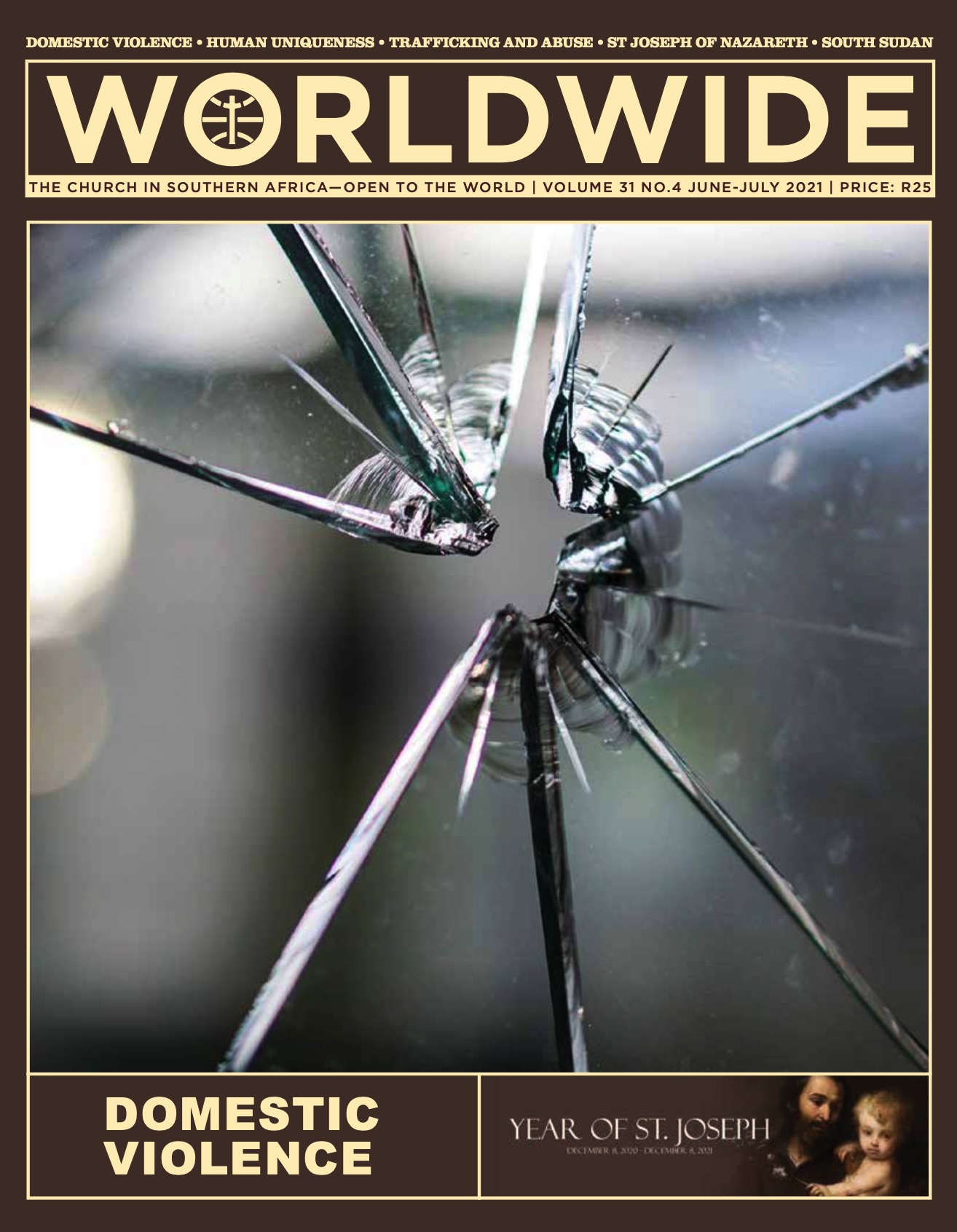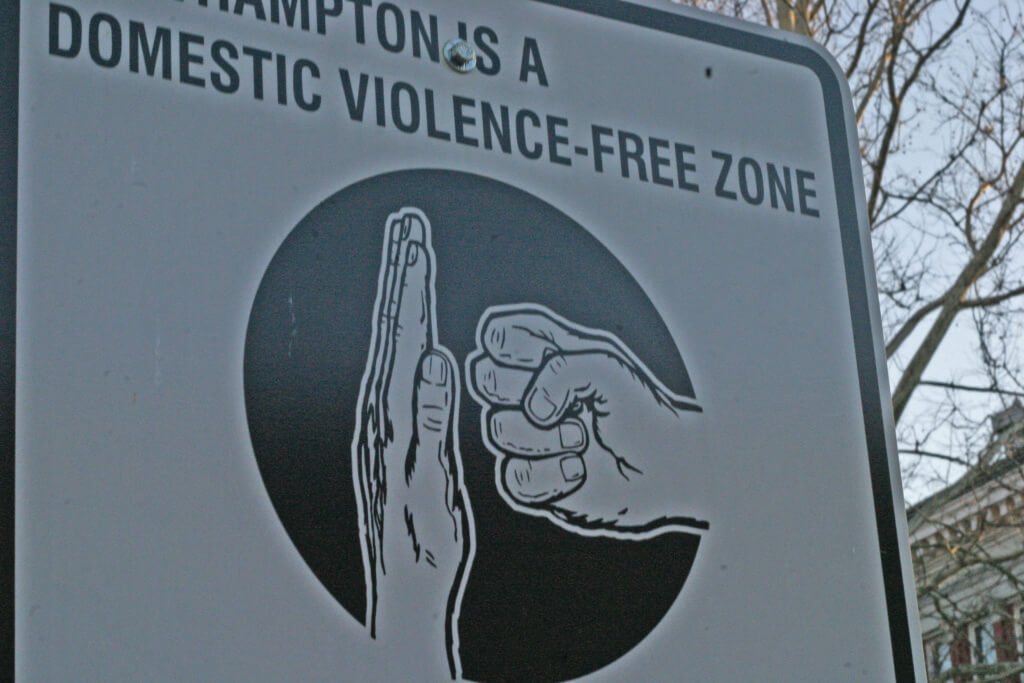
Domestic Violence
The shattered glass represents the broken lives and dreams caused by domestic violence. abuses in families are absolutely contrary to God’s plan of mutual care and fraternity for humanity. domestic violence, inflicted especially upon women and children, is a horrendous scourge. To eradicate it we need to foster the education on values of love, equality, respect and dialogue, in society. The alleviation of poverty, protection of the vulnerable and law enforcement will give the victims the courage to speak out and unveil this atrocious crime.
Special Report • Domestic Violence

A Secret Reality
BY LT. COL. GERBER | POLICE SOCIAL WORK SERVICES, PRETORIA
PEOPLE LIVE with preconceived ideas of an ideal life. They believe that everything will go as anticipated; they grow up in a comfortable home with loving parents and will one day meet Mr or Miss right and eventually live happily ever after, with no conflicts and challenges in the relationships
Unfortunately, in many homes, this is not how it works; instead, partners fight and children are neglected and/or abused; this is the reality of domestic violence (DV), the silent killer behind closed doors that no one dares to talk about because it is a family matter. Little do we know that victims reside indoors, fighting for their survival. Furthermore, the lockdown situations due to COVID make it difficult for people to speak out and to seek help in those circumstances. DV ruins lives, breaks up families and has a lasting impact. It never discriminates, but embraces all races, cultures, economic statuses and all sexes and genders.
The Domestic Violence Act, 1998 (Act no. 116 of 1998) defines DV as “physical abuse; sexual abuse; emotional, verbal and psychological abuse; economic abuse; intimidation; harassment; stalking; damage to property; entry into the complainant’s residence without consent, where the parties do not share the same residence; or any other controlling or abusive behaviour towards a complainant, where such conduct harms, or may cause imminent harm to, the safety, health or wellbeing of the complainant…”. It is any ongoing threatening, abusive, or violent behaviour in an intimate or domestic relationship, with one purpose: to gain and maintain control over a person. DV can occur in many forms, but more so in a combination thereof—which makes it such a complex and challenging phenomenon to address.
FORMS OF DOMESTIC VIOLENCE
Physical abuse intends to cause pain, injury, suffering or bodily harm; it comprises hitting, slapping, punching, choking, behaviours such as denying the victim medical care, depriving a person of sleep or other functions necessary to live, and/or abusing, injuring, or threatening others such as children, pets, or special property.
Sexual abuse, implies forcing another person to engage in sexual activity against one’s will, even if that person is a spouse or intimate partner with whom consensual sex has previously occurred. Sexual abuse includes marital rape and exploiting a victim who is unable to make an informed sexual decision because of being asleep, intoxicated, drugged, disabled, too young, too old, or dependent upon or afraid of the perpetrator; as well as sharing sexually explicit images of a partner online, such as ‘revenge porn’, or elsewhere.
Emotional/psychological abuse is any behaviour that exploits another’s vulnerability, insecurity or character, and threatens, intimidates and humiliates them privately or publicly. It includes continuous criticism, name calling, mocking or belittling, degradation, manipulation, brainwashing, isolation, harassment and/or controlling of the individual. Targeted, repeated emotional abuse can severely affect the victim’s sense of self and of reality.
Economic abuse occurs when one intimate partner controls the victim through economic resources, including family income, keeping financial secrets or hidden accounts and/or causing the victim to lose a job or preventing him/her from taking a job. This manipulation prevents the victim from being in a position to support him/herself—thus, forcing him/her to depend on the perpetrator financially. The law prohibits breadwinners from stopping their partner from having money or giving them punitive allowances.
Coercive abuse when the perpetrator exerts control over another person restricting the person from seeing friends or family, monitoring calls, emails and movements; intimidating by gestures, shouting, destroying things or punching walls; imposing on the partner their rules; controlling what the partner wears; threatening to reveal private information about the partner’s health or sexual orientation; tracking through devices on phones, monitoring the victim’s social media and location; being extremely jealous and accusing the person of cheating by simply looking at another individual; forcing the partner to do things, including crimes, and neglecting or abusing the children.
Honour abuse is a behaviour that involves violence, intimidation, coercion or any kind of abuse (psychological, physical, sexual, financial or emotional) which occurs when perpetrators perceive that a relative has shamed the family and/or community by breaking their honour code, such as by perceived immoral behaviour.
Coercive and honour abuses are ‘hidden’ ways of violence, often culturally based, and so, more difficult to challenge in some contexts.
IMPACT OF DOMESTIC VIOLENCE
DV impacts greatly not only on the victim, but also on the abuser, the children, family and colleagues. It ripples out to the next generation, starting an evil cycle of abuse in families. The violence impacts not only on the obvious physical injuries, but also on the person(s)’ work performance, psychological wellness, and on the children.
Physical / Health
Physical harm and injuries can lead to permanent disfigurement and/or disability, which impacts on the emotional and financial wellness of the affected person; if severe, it can cause the death of the victim, a witness, or the perpetrator.
Psychological
The power and control game removes all self-worth and independence of the victims who can believe that they mean nothing and deserve the abuse, thinking even that there is no hope. The victims are isolated from all support systems, rendering their capacity to change the situation or circumstances nearly impossible.

Image: John Hain, Pixabay.
In the workplace
DV does not stop and stay at home when its victims or perpetrators go to work, but follows them, resulting in violence in the workplace. The abuser can enter the building and become violent or the ‘low self-esteem’ can be compromised by workplace bullying. Work performance and productivity decreases, which impacts greatly on the economic situation globally.
On children
Physical abuse between parents may result in children being injured accidentally, being struck during the argument. Children who are exposed to DV during their upbringing will likely suffer in their developmental and psychological welfare and the child will use violence as a way to communicate and/or respond in all situations. School bullying is a good example of this behaviour. Children often bully because they are (in some way or another) being bullied themselves. This learned behaviour often leads into the adult becoming an abuser or willingly a victim since violence has been the norm during the upbringing of the child.
Financial
When the victims leave the abusers, their financial independence is often very limited with very little money of their own and few people on whom they can rely when seeking help. This is one of the greatest obstacles facing victims of DV and the strongest factor that can discourage them from leaving their perpetrators.
CONTRIBUTING FACTORS TO DV
Although DV is a choice in behaviour, there are theories that postulate the existence of contributing factors to DV. These include psychological theories that consider personality traits such as the need to control, a poor self-esteem and feelings of powerlessness and the mental characteristics of the perpetrator.
Social theories look at external factors in the perpetrator’s environment, such as family structure, stress, social learning, culture and religion. Social stress comprises challenges originated from inadequate or poor financial management, an unhappy marriage or work-related problems. Social learned behaviour refers to violence observed and normalized, transmitted from generation to generation, that feeds DV behaviour.
Culture and religion could also foster patriarchal belief that men have the right to discipline their wives, or that lobola pays for the wife to be the husband’s property. Most religions believe that marriage is sacred and that divorce is a sin. One should love and forgive each other unconditionally and always turn the other cheek. This belief in a ‘sick’ mind could make violent behaviour acceptable.
WHY NOT JUST LEAVE?
We can question ourselves why it is so difficult to simply pack the bag, get help and get over these situations. The reality, however, is that DV is like a spiderweb that pulls one in with magnetic force, unwillingly and seemingly impossible to get out. It is a black hole that consumes self-worth and strength and the more one struggles, the stronger the forces become. It is a game of power and control that breaks the victim to the point when survival is a mere thought and in another life. The victim experiences feelings of hopelessness and rejection and for the most there is also the challenge of the lack of income, housing and a support system. The threats and aggressive behaviour from the abuser often make it very dangerous to leave the relationship without proper planning.
Moreover, to report a DV case is a very traumatic experience for the victim. By the time they get to a police station, a lot of abuse has already happened. If not handled properly (with the necessary sympathy), the victim loses courage halfway through the process and withdraws the case.
Economic hardship experienced by the victim also plays a major role in withdrawing the DV complaint. In many cases, the offender is the only breadwinner and the imprisonment of that breadwinner will have a negative impact on the family’s financial survival. For the sake of the children, the abuse continues. Some victims do not want the children’s parent (abuser) to have a criminal record. Victims also receive a lot of pressure from their relatives or members of the community to ‘drop the charges’.
